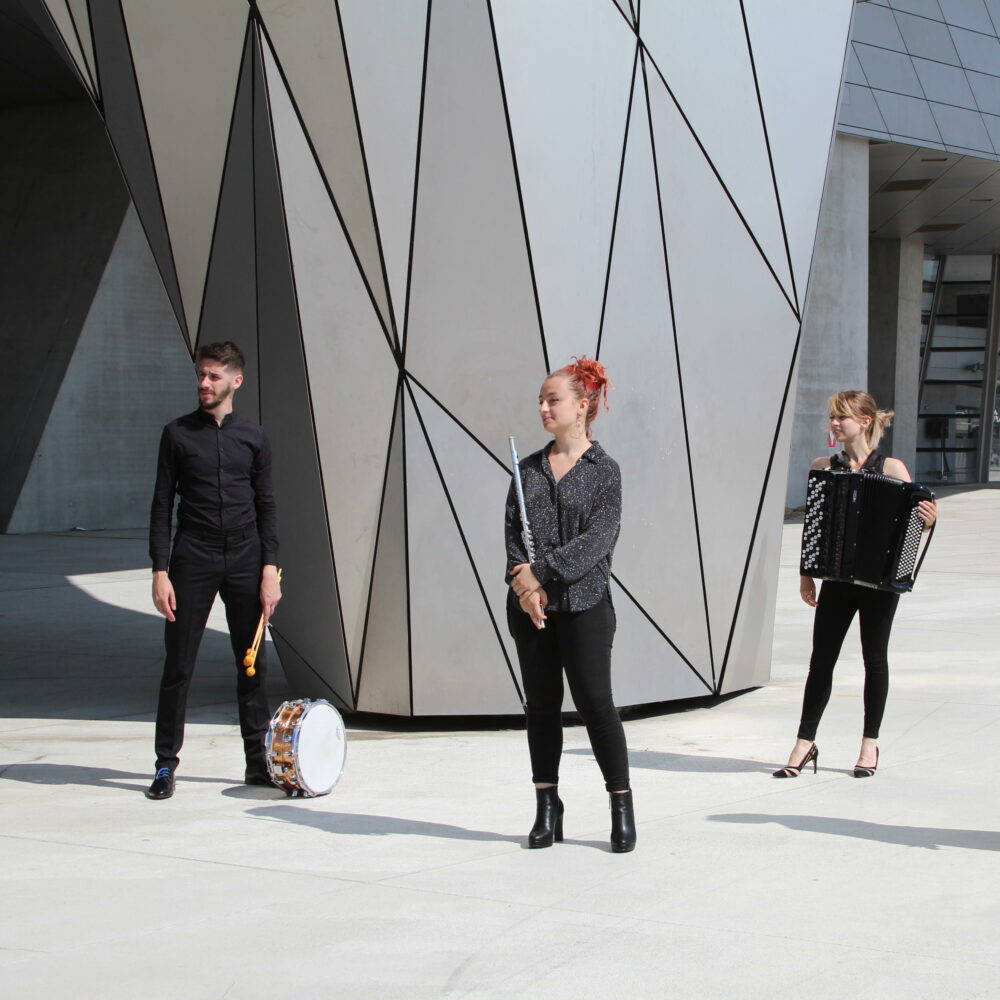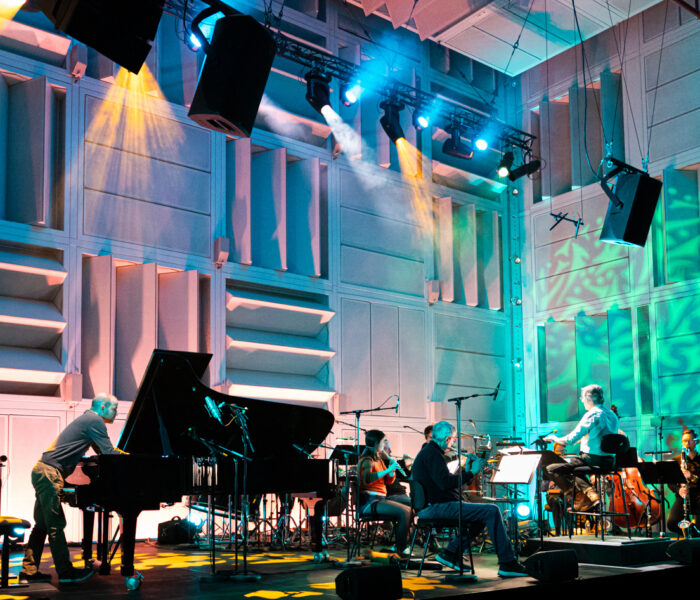Reçu dans les salons luxueux de l’Ambassade d’Argentine, le tout jeune Ensemble Orbis voué à la musique d’aujourd’hui donne son premier concert parisien en affichant sept pièces pour soliste ou petit ensemble.
Ils sont quatre instrumentistes (flûte, saxophone, accordéon et percussion), deux compositrices et un compositeur, tous issus du Conservatoire National Supérieur de Musique et de Danse (CNSMD) de Lyon où certains terminent encore leur formation. Placé sous la direction artistique du compositeur, guitariste et vidéaste argentin Demian Rudel Rey, Orbis (Boussole en latin) s’est créé en 2021 et vient de bénéficier d’une résidence au Portugal.
Le concert démarre dans l’énergie et le son amplifié avec Átropos, une pièce pour saxophone, percussion et électronique de la compositrice argentine Rocio Cano Valiño, co-fondatrice de l’ensemble, qui est ce soir aux manettes du dispositif électronique. Le set de percussions est riche, un vibraphone central et de nombreuses petites percussions aux mains de Louis Quiles, qui contribue à forger le timbre avec la saxophoniste Yui Sakagoshi. C’est elle, via une pédale de déclenchement, qui gère le traitement électronique. Après une première partie très éruptive, le deuxième volet s’oriente vers un son plus bruiteux, frottement, souffle, slaps du saxophone, dans une atmosphère intimiste et poétique à laquelle contribue l’effleurement des balais sur les lames du vibraphone. Le titre Dots, lines and roughness (« Points, lignes et rugosité ») d’Elsa Justel, synthétise le travail d’orfèvre sur les morphologies sonores que donne à entendre cette pièce acousmatique (qui passe par les haut-parleurs) dont la diffusion sur deux enceintes et à trop bas régime ne rend hélas pas justice. La flûtiste Fanny Martin met, quant à elle, toute son énergie et sa réactivité dans la pièce virtuose de Philippe Hurel Eolia sollicitant le souffle mais aussi la voix de l’interprète : c’est une sorte de récit imaginaire plein de saillies et de rebondissements qui engage le corps tout entier de l’interprète et nous tient en haleine jusqu’au point final.
L’Ensemble Orbis a passé commande à Lisa Heute, accordéoniste et compositrice qui joue sa propre pièce, Cantique du serpent, aux côtés de ses trois partenaires, Fanny Martin, Yui Sakagoshi et Louis Quiles. L’écriture génère une trame à évolution lente entretenue par les différents timbres qui la composent et un espace mouvant qui modifie les couleurs et renouvelle constamment la texture dans une temporalité étirée.
Bossa nova de Franck Bedrossian, que Lisa Heute joue juste après, accuse le contraste, articulant les gestes sonores dans un temps resserré et un espace hétérogène autant qu’accidenté. On passe du son saturé aux bruits générés par les percussions sur l’instrument et l’effet guiro (raclement) sur le soufflet. Les sons aigus évoquent les fréquences électroniques, un univers de référence pour le compositeur dans cette partition très bien défendue par notre interprète.
On s’interroge sur le sens du titre Retour du Rite d‘Alex Nante, autre compositeur argentin au programme de la soirée. Dans cette pièce pour saxophone soprano, Nante procède à une exploration fantasque autant qu’obstinée du spectre sonore de l’instrument, avec cette manière élégante et ciselée de conduire son écriture que Yui Sakagoshi restitue avec la même finesse.
La dernière pièce, Cuélebre, de Demian Rudel Rey, pour flûte, saxophone, accordéon, percussion, électronique et vidéo, est dirigée par le compositeur et donnée ce soir sans le support visuel. Rudel Rey aime puiser son inspiration dans les mondes reculés, l’antiquité pour son opéra Qu’est-ce-que l’amour? ou les mythologies hispaniques pour ce Cuélebre. Il désigne une créature ailée que l’on retrouve dans les régions celtiques de l’Espagne. Son corps est écailleux, de couleur verte et rouge. Quand il atteint des proportions gigantesques et que ses écailles deviennent dures comme fer, il s’envole vers la mer pour plonger dans ses profondeurs et veiller sur les nombreux trésors qui s’y cachent : autant d’images fantastiques qui vont générer une écriture foisonnante, pleine de saillies rythmiques, de couleurs évocatrices mâtinées d’électronique et zébrées de sons-fusée saturés. Cette jungle sonore et luxuriante, portée à des sommets d’intensité, est entretenue par une percussion très active. C’est elle, dans le bruit blanc des peaux frottées et les pixels de la flûte, qui termine la pièce, très mystérieusement…
Jeunes et déjà très aguerris, les membres d’Orbis nous impressionnent par leur talent et l’engagement tant musical que scénique déployé dans ce programme exigeant qui nous fait voyager d’une rive à l’autre, entre frénésie rythmique et spectre coloré. On les retrouve en concert le 9 février au pôle Pixel de Lyon, dans le cadre de la saison du Grame, Centre National de Création Musicale (CNCM) qui fête cette année ses quarante ans d’existence.
Michèle Tosi
Ambassade d’Argentine à Paris, le 26-01-2023
Rocio Cano Valiño (née en 1991) : Átropos pour saxophone, percussion et électronique ; Elsa Justel (née en 1944) : Dots, lines and roughness, pour électronique ; Philippe Hurel (né en 1955) : Eolia pour flûte ; Lisa Heute (née en 1991) : Cantique du Serpent, pour flûte, saxophone, accordéon et percussion ; Franck Bedrossian (né en 1971) : Bossa Nova pour accordéon ; Alex Nante (né en 1992) : Retour du Rite, pour saxophone soprano ; Demian Rudel Rey (né en 1987) : Cuélebre, pour petit ensemble. Ensemble Orbis : Fanny Martin, flûte ; Yui Sakagoshi, saxophone ; Lisa Heute, accordéon ; Louis Quiles, percussion ; Rocío Cano Valiño, électronique ; Demian Rudel Rey, direction.



)



